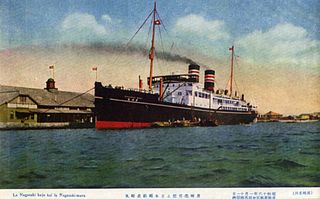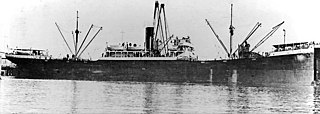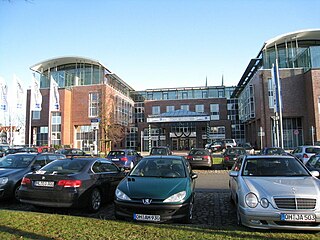
A clipper was a type of mid-19th-century merchant sailing vessel, designed for speed. Clippers were generally narrow for their length, small by later 19th-century standards, could carry limited bulk freight, and had a large total sail area. "Clipper" does not refer to a specific sailplan; clippers may be schooners, brigs, brigantines, etc., as well as full-rigged ships. Clippers were mostly constructed in British and American shipyards, although France, Brazil, the Netherlands, and other nations also produced some. Clippers sailed all over the world, primarily on the trade routes between the United Kingdom and China, in transatlantic trade, and on the New York-to-San Francisco route around Cape Horn during the California Gold Rush. Dutch clippers were built beginning in the 1850s for the tea trade and passenger service to Java.

Cunard is a British shipping and cruise line based at Carnival House at Southampton, England, operated by Carnival UK and owned by Carnival Corporation & plc. Since 2011, Cunard and its three ships have been registered in Hamilton, Bermuda.

Albert Ballin was a German shipping magnate. He was the general director of the Hamburg-Amerikanische Packetfahrt-Actien-Gesellschaft (HAPAG) or Hamburg-America Line, which for a time was the world's largest shipping company. Being the inventor of the concept of the cruise ship, he is known as the father of modern cruise ship travel. Albert Ballin was a risk-taker who was willing to challenge his colleagues, foreign competitors, and domestic politics in order to build a successful shipping company. He focused on British rivals and was determined to expand HAPAG's global reach. A Jew, he nevertheless worked closely with the Kaiser and supported expansion of the German navy.

An ocean liner is a type of passenger ship primarily used for transportation across seas or oceans. Ocean liners may also carry cargo or mail, and may sometimes be used for other purposes. Only one ocean liner remains in service today.

The Age of Sail is a period that lasted at the latest from the mid-16th to the mid-19th centuries, in which the dominance of sailing ships in global trade and warfare culminated, particularly marked by the introduction of naval artillery, and ultimately reached its highest extent at the advent of the analogue Age of Steam. Enabled by the advances of the related Age of Navigation, it is identified as a distinctive element of the early modern period and the Age of Discovery. Especially in context of the latter, it refers to a more particular Eurocentric Age of Sail, while generally the Age of Sail is the culminating period of a long intercontinental history of sailing.

The Flying P-Liners were the sailing ships of the German shipping company F. Laeisz of Hamburg.
Norddeutscher Lloyd was a German shipping company. It was founded by Hermann Henrich Meier and Eduard Crüsemann in Bremen on 20 February 1857. It developed into one of the most important German shipping companies of the late 19th and early 20th centuries, and was instrumental in the economic development of Bremen and Bremerhaven. On 1 September 1970, the company merged with Hamburg America Line (HAPAG) to form Hapag-Lloyd AG.

Ellerman Lines was a UK cargo and passenger shipping company that operated from the late nineteenth century and into the twentieth century. It was founded in the late 19th century, and continued to expand by acquiring smaller shipping lines until it became one of the largest shipping firms in the World. Setbacks occurred through heavy losses to its merchant fleet in the First and Second World Wars but were overcome in each case.

Hamburg Südamerikanische Dampfschifffahrts-Gesellschaft A/S & Co KG, widely known as Hamburg Süd, was a German container shipping company. Founded in 1871, Hamburg Süd was among the market leaders in the North–South trade. It also served all significant East–West trade lanes.

A shipping line or shipping company is a company whose line of business is ownership and operation of ships.

USS West Carnifax (ID-3812) was a cargo ship in the United States Navy shortly after World War I. After she was decommissioned from the Navy, the ship was known as SS West Carnifax, SS Exford, and SS Pan Royal in civilian service under American registry.

Greece is a maritime nation by tradition, as shipping is arguably the oldest form of occupation of the Greeks and has been a key element of Greek economic activity since ancient times. Today, shipping is the country's most important industry worth $21.9 billion in 2018. If related businesses are added, the figure jumps to $23.7 billion, employs about 392,000 people, and shipping receipts are about 1/3 of the nation's trade deficit. In 2018, the Greek Merchant Navy controlled the world's largest merchant fleet, in terms of tonnage, with a total DWT of 834,649,089 tons and a fleet of 5,626 Greek-owned vessels, according to Lloyd's List. Greece is also ranked in the top for all kinds of ships, including first for tankers and bulk carriers.

The Moore-McCormack Lines was a series of companies operating as shipping lines, operated by the Moore-McCormack Company, Incorporated, later Moore-McCormack Lines, Incorporated, and simply Mooremack, founded in 1913 in New York City. It ceased trading on its buy-out in 1982. The founders were Albert V. Moore (1880–1953) (director/president) and Emmet J. McCormack (director/treasurer), with Mr Molloy (director/secretary).

Robert Miles Sloman was an English-German shipbuilder and ship owner.

Hugo Stinnes Schiffahrt GmbH is a shipping company based in Rostock, Germany which specializes in container service between Germany and South Africa, and in transporting cargo between Northern Europe, the Caribbean and Mexico. It was part of the former conglomerate Hugo Stinnes GmbH.
The Green Star Line was an American steamship shipping line created in 1919 and operated until 1923. Established by Irish businessmen as a response to the Shipping Board's campaign urging Americans to buy ships for wealth and patriotism during and after World War I.

The Koninklijke Nederlandse Stoomboot-Maatschappij (KNSM) was an Amsterdam-based shipping company that existed from 1856 to 1981. It was once the largest company in Amsterdam and one of the top five shipping lines in the Netherlands. The company operated mid-sized freighters that had limited passenger accommodations. At its peak in 1939, the company had 79 vessels. Of these, 48 were lost during World War II.

Lamport and Holt was a UK merchant shipping line. It was founded as a partnership in 1845, reconstituted as a limited company in 1911 and ceased trading in 1991.

Oldendorff Carriers is a family owned shipping company with headquarters in Lübeck.
Peter Döhle Schiffahrts-KG ("PD") is a seaborne shipping company and maritime service provider headquartered in Hamburg, Germany. It is the parent holding company of the Döhle Group which has several affiliates and is operating worldwide. The Company owns and operates a fleet of container vessels, multi-purpose vessels and bulk carriers. The group of companies employs worldwide around 4,800 crew members as well as 2,000 employees ashore.

















